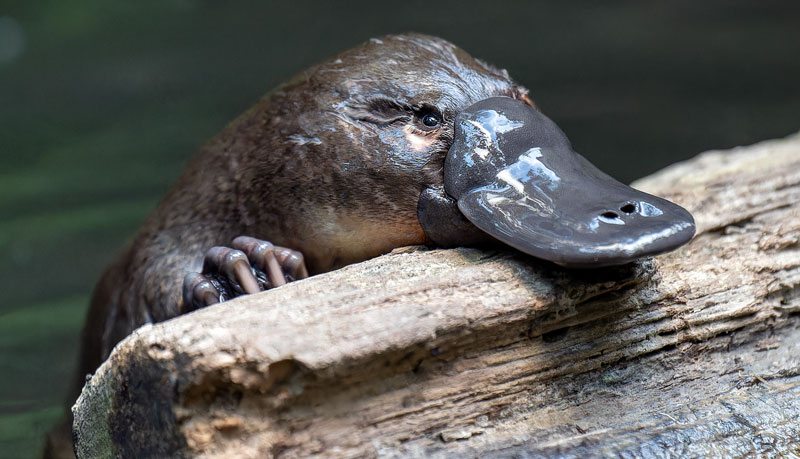Free Courses Sale ends Soon, Get It Now


Free Courses Sale ends Soon, Get It Now



Copyright infringement not intended
Picture Courtesy: hobartrivuletplatypus.org
Context: The research conducted after the Black Summer bushfires in 2019-20 in eastern Australia sheds light on the impact of these mega-fires on platypuses and their habitats.
Key Highlights of the Research
|
About Platypus |
|
|
Monotremes |
●Platypuses, along with echidnas, are the only two extant (living) monotreme species. ●Monotremes are a primitive group of mammals known for their egg-laying reproduction, a trait they share with their ancestors from the distant past. |
|
Physical Characteristics |
●They have a streamlined body adapted for an aquatic lifestyle. Their body length can range from 30 to 45 centimetres (12 to 18 inches). ●They have dense, waterproof fur that helps them stay warm in the water. The fur traps a layer of air close to their skin, providing insulation. ●They have webbed front limbs that make them excellent swimmers. Their partially webbed hind feet act like rudders, aiding in steering. ●The platypus's bill is a remarkable feature. It's soft and sensitive, containing electroreceptors that can detect the electrical signals produced by the muscles and nerves of prey in the water. ●Male have a venomous spur on their hind legs. This spur is capable of delivering a painful venomous sting to potential threats or rivals during the breeding season. |
|
Habitat |
●They are highly adaptable and can be found in a variety of freshwater environments, including rivers, streams, and lakes. They are particularly well-suited to habitats with plenty of submerged vegetation and access to burrows for shelter. ●Platypus ancestors can be traced back to fossil records in Australia. They are believed to have originated and evolved in the ancient supercontinent of Gondwana, making them one of the oldest lineages of mammals. |
|
Feeding |
●They are carnivorous and primarily feed on aquatic invertebrates. Their diet includes a wide range of prey such as insect larvae, crustaceans, worms, and small amphibians. ●They locate their prey by detecting vibrations and electrical impulses produced by movements in the water. |
|
Activity and Behavior |
●They are primarily crepuscular (active at dawn and dusk) and nocturnal (active at night). ●They are solitary animals and typically maintain their territories, which they mark with scent markings. ●They are known for their burrowing behaviour. They dig burrows along the banks of water bodies, providing a safe place to rest and rear their young. ●While platypuses are generally quiet animals in the wild, they can produce a variety of vocalizations, including low growls, hisses, and grunts, especially when disturbed or handled. |
|
Reproduction |
●Female platypuses lay one to three eggs in a specially constructed burrow. After laying the eggs, the female incubates them by curling her body around them. The eggs hatch after about ten days. ●The mother feeds her young with milk secreted from mammary glands and absorbed through the skin, as platypuses do not have nipples. The young platypuses are weaned at around 3-4 months of age. |
|
Conservation Status |
●Platypuses are listed as "Near Threatened" by the International Union for Conservation of Nature (IUCN). Their conservation status is of concern due to habitat destruction, pollution of waterways, and climate change. Protecting their freshwater habitats is crucial for their survival. ●While the main predators of platypuses are not well-documented, potential threats include crocodiles, large birds of prey, and certain reptiles. On land, foxes and dingoes may pose a danger to platypuses when they venture out of the water. |
Conclusion
|
PRACTICE QUESTION Q. Consider the following statements in the context of the Platypuses: 1. They are mammals known for giving birth to live young. 2. They are primarily crepuscular and nocturnal animals. 3. They primarily feed on plants and vegetation. 4. They are listed as "Near Threatened" by the IUCN. How many of the above statement is/are correct? A) Only one B) Only two C) Only three D) All four Answer: B Explanation: Statement 1 is Incorrect: ●Platypuses are mammals, but they do not give birth to live young. They are one of the few species of mammals known for egg-laying reproduction. Along with echidnas, they are classified as monotremes, a primitive group of mammals that lay eggs instead of giving birth to live offspring. Female platypuses lay eggs, and after incubating them, they hatch into young platypuses. Statement 2 is correct: ●Platypuses are primarily crepuscular, which means they are most active during the periods of dawn and dusk. They are also nocturnal, meaning they are active during the night. These activity patterns are adapted to their hunting and feeding behaviours, which are more effective in low-light conditions. Statement 3 is Incorrect: ●Platypuses are carnivorous and primarily feed on aquatic invertebrates. Their diet includes a variety of prey such as insect larvae, crustaceans, worms, and small amphibians. They are well adapted to hunting these prey in freshwater environments using their electroreceptors to detect movements and electrical signals in the water. Statement 4 is correct: ●Platypuses are indeed listed as "Near Threatened" by the International Union for Conservation of Nature (IUCN). Their conservation status is a cause for concern due to various threats, including habitat destruction, pollution of waterways, and climate change. Protecting their freshwater habitats is essential for their survival, and their listing as "Near Threatened" reflects these conservation concerns. |
© 2024 iasgyan. All right reserved